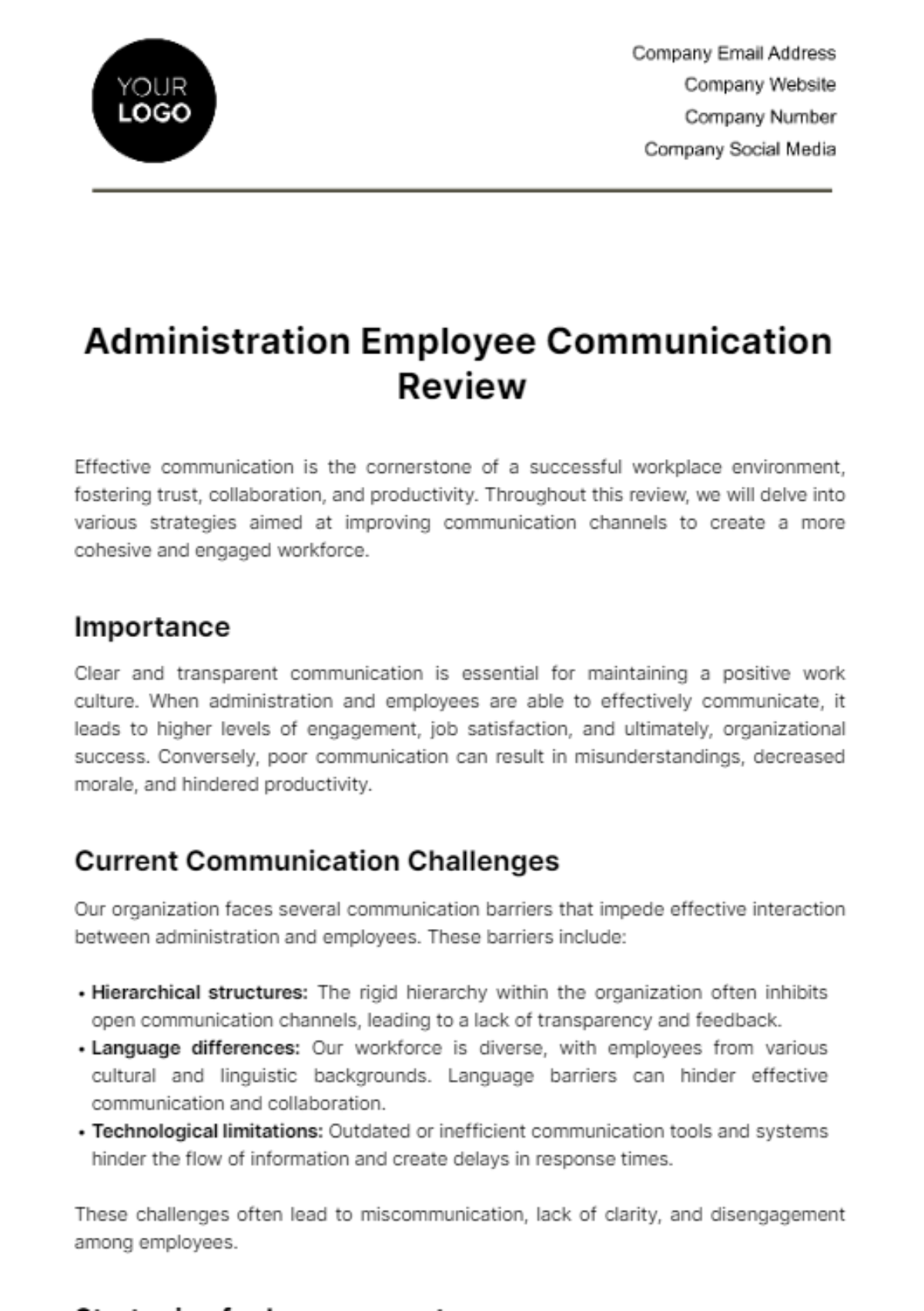Administration Employee Communication Review
Effective communication is the cornerstone of a successful workplace environment, fostering trust, collaboration, and productivity. Throughout this review, we will delve into various strategies aimed at improving communication channels to create a more cohesive and engaged workforce.
Importance
Clear and transparent communication is essential for maintaining a positive work culture. When administration and employees are able to effectively communicate, it leads to higher levels of engagement, job satisfaction, and ultimately, organizational success. Conversely, poor communication can result in misunderstandings, decreased morale, and hindered productivity.
Current Communication Challenges
Our organization faces several communication barriers that impede effective interaction between administration and employees. These barriers include:
Hierarchical structures: The rigid hierarchy within the organization often inhibits open communication channels, leading to a lack of transparency and feedback.
Language differences: Our workforce is diverse, with employees from various cultural and linguistic backgrounds. Language barriers can hinder effective communication and collaboration.
Technological limitations: Outdated or inefficient communication tools and systems hinder the flow of information and create delays in response times.
These challenges often lead to miscommunication, lack of clarity, and disengagement among employees.
Strategies for Improvement
To address these challenges, we propose implementing a series of strategies to enhance administration-employee communication:
Regular team meetings: Schedule regular team meetings to provide updates, share important information, and gather feedback from employees. These meetings should be inclusive and encourage active participation from all team members.
Diverse communication channels: Utilize various communication channels such as email, instant messaging platforms, and collaboration tools to cater to different communication preferences and needs.
Open-door policy: Foster an open-door policy where employees feel empowered to approach administration with concerns, ideas, or feedback. This open communication culture promotes transparency and trust within the organization.
Training and Development
Investing in communication training and development programs for both administration and employees is crucial. These programs can include:
Communication workshops: Offer workshops and seminars focused on improving communication skills, active listening, and conflict resolution techniques.
Language classes: Provide language classes or resources for employees who may face language barriers in their communication.
Technology training: Offer training sessions to familiarize employees with communication tools and platforms to ensure efficient utilization.
Feedback Mechanisms
Establishing formal feedback mechanisms is essential for gathering insights and addressing concerns. This can be achieved through:
Suggestion boxes: Place suggestion boxes in common areas where employees can anonymously submit their feedback, suggestions, or concerns.
Surveys: Conduct regular surveys to collect feedback on various aspects of communication, organizational culture, and employee satisfaction.
Regular check-ins: Schedule one-on-one or team check-in meetings to provide opportunities for employees to voice their concerns or ideas in a supportive environment.
Recognition and Appreciation
Recognizing and appreciating employees' contributions is key to maintaining motivation and morale. Strategies for recognition and appreciation include:
Verbal praise: Encourage supervisors and managers to regularly recognize and acknowledge employees' efforts and achievements through verbal praise.
Awards and incentives: Implement an employee recognition program that includes awards, incentives, or bonuses for outstanding performance or contributions.
Success stories: Share success stories and examples of effective communication leading to positive outcomes to inspire and motivate employees.
Case Studies
Throughout this review, we will explore real-life case studies of organizations that have successfully improved administration-employee communication. By examining their strategies and outcomes, we can gain valuable insights into how similar approaches can be implemented within our own organization.
Implementation Plan
Finally, we will outline a comprehensive implementation plan for integrating these communication enhancement strategies into our organization. This plan will include specific actions, timelines, and responsibilities to ensure successful execution. Key steps include:
Conducting a communication audit to identify current strengths and areas for improvement.
Developing communication guidelines and protocols to ensure consistency and clarity.
Providing training and resources to support employees in adopting new communication practices.
Establishing metrics and feedback mechanisms to measure the effectiveness of communication initiatives and make necessary adjustments.
In conclusion, effective administration-employee communication is essential for fostering a positive work environment and driving organizational success. By implementing the strategies outlined in this review and prioritizing open, transparent communication, we can cultivate a culture of collaboration, trust, and mutual respect within our organization.
Administration Templates @ Template.net






























